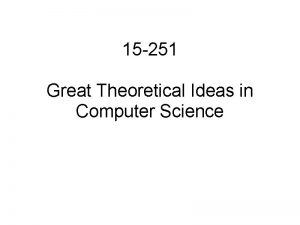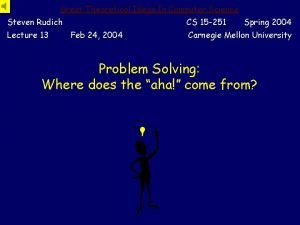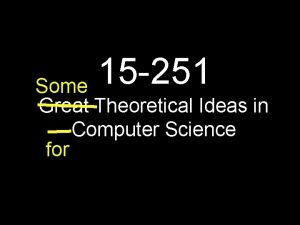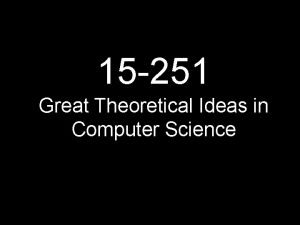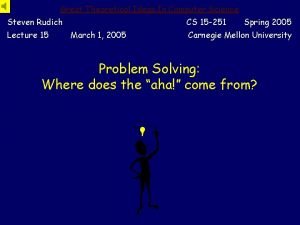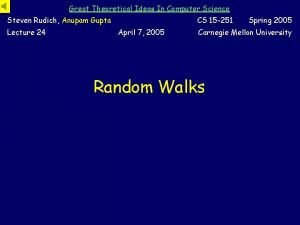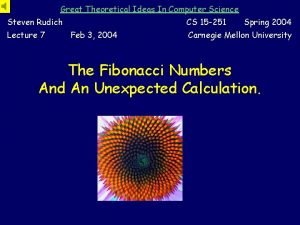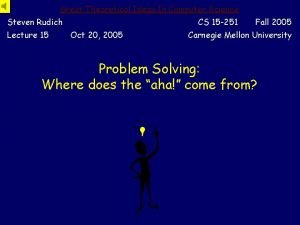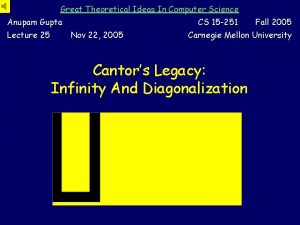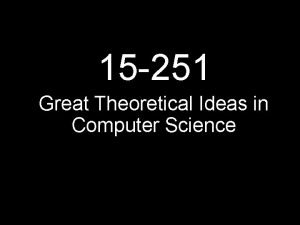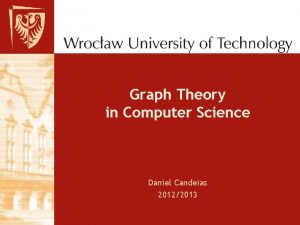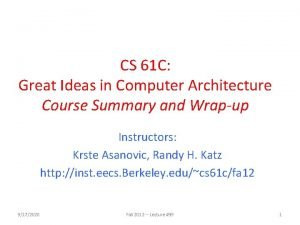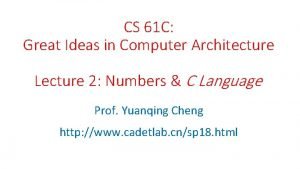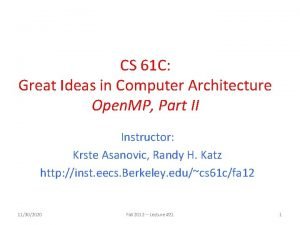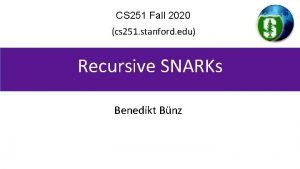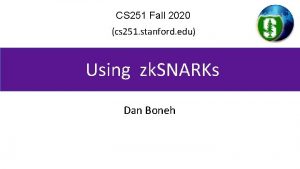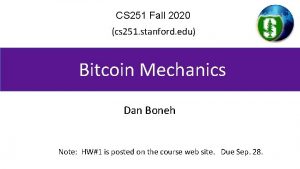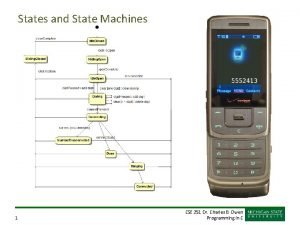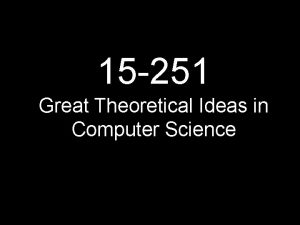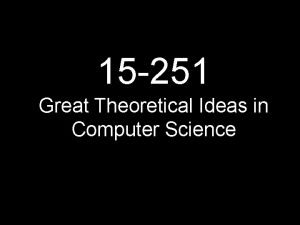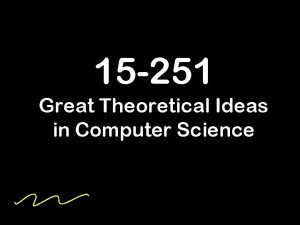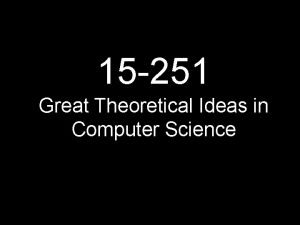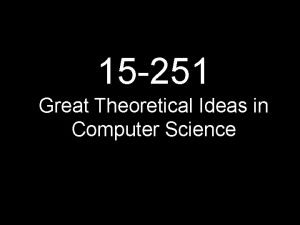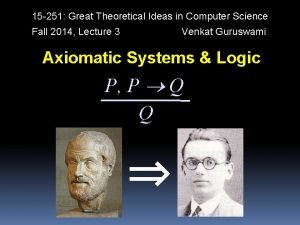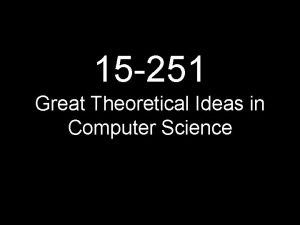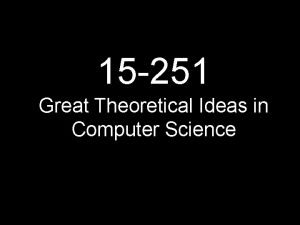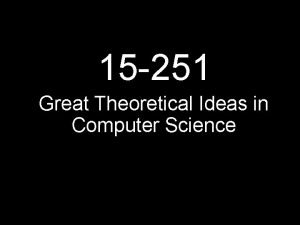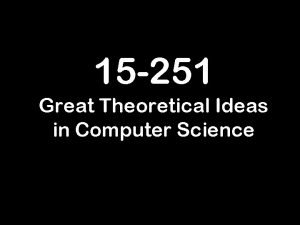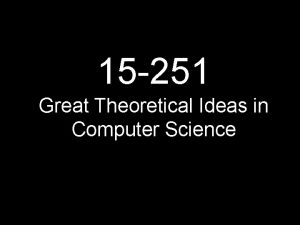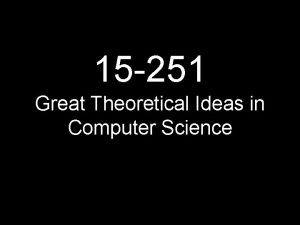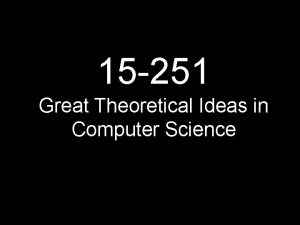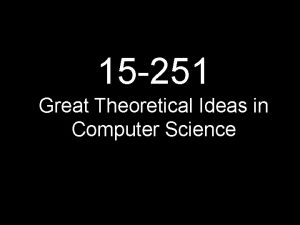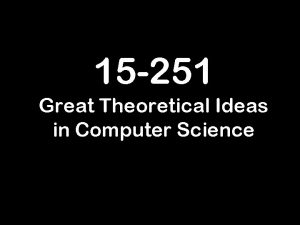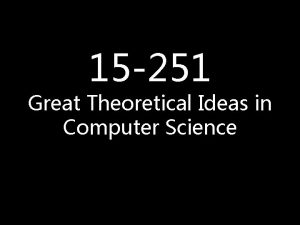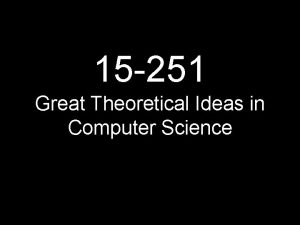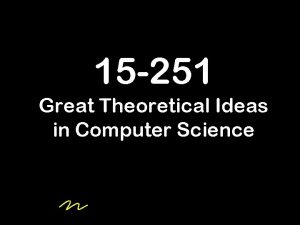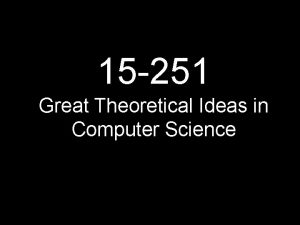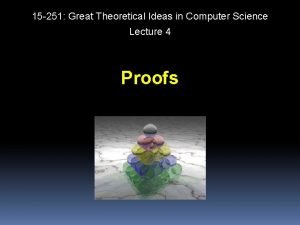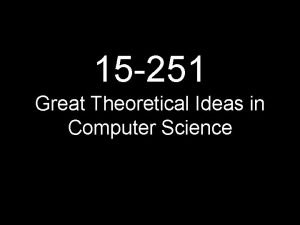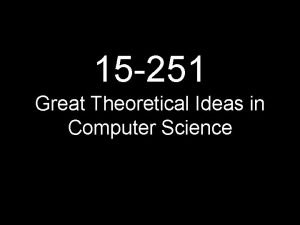15 251 Great Theoretical Ideas in Computer Science
















































![And try to improve it… [Christofides (CMU) 1976]: There is a simple 1. 5 And try to improve it… [Christofides (CMU) 1976]: There is a simple 1. 5](https://slidetodoc.com/presentation_image/0db810a7d1953b124af4c880f1c99a90/image-49.jpg)


- Slides: 51

15 -251 Great Theoretical Ideas in Computer Science

Approximation and Online Algorithms Lecture 28 (November 30, 2010)

In the previous lecture, we saw two problem classes: P and NP

The Class P We say a set L Σ* is in P if there is a program A and a polynomial p( ) such that for any x in Σ*, A(x) runs for at most p(|x|) time and answers question “is x in L? ” correctly.

The Class P The class of all sets L that can be recognized in polynomial time. The class of all decision problems that can be decided in polynomial time.

P contains many useful problems: • graph connectivity • minimum spanning tree • matchings in graphs • shortest paths • solving linear systems Ax = b • linear programming • maximum flows Many of this we will (re)visit in 15 -451.

NP A set L NP if there exists an algorithm V and a polynomial p( ) such that For all x L there exists y with |y| p(|x|) For all y with |y | p(|x |) such that V(x, y) = YES such that V(x , y ) = NO in p(|x|) time “exists a quickly-verifiable proof” “all non-proofs rejected”

The Class NP The class of sets L for which there exist “short” proofs of membership (of polynomial length) that can be “quickly” verified (in polynomial time). Recall: V doesn’t have to find these proofs y; it just needs to be able to verify that y is a “correct” proof.

P NP For any L in P, we take the “proof” y to be the empty string, and V(x, y) = A(x) to satisfy the requirements. Hence, every language in P is also in NP. in this case, “the computation is the proof”

Summary: P versus NP Set L is in P if membership in L can be decided in poly-time. Set L is in NP if each x in L has a short “proof of membership” that can be verified in poly-time. Fact: P NP Million (Billion) $ question: Does NP P ?

NP-hard and NP-complete L is NP-hard if a polynomial-time algorithm for L implies a polynomial-time algorithm for all of NP to show NP-hardness for L, find another NP-hard problem (say SAT), and reduce SAT to L. L is NP-complete if L is NP-hard and L itself belongs to NP.

NP Contains Lots of Problems We Don’t Know to be in P Classroom Scheduling Packing objects into bins Scheduling jobs on machines Finding cheap tours visiting a subset of cities Allocating variables to registers Finding good packet routings in networks Decryption …

What do we do now? We’d really like to solve these problems. But we don’t know how to solve them in polynomial time… A solution for some of these: Try to solve them “approximately”

E. g. Scheduling Jobs on Machines Input: A set of n jobs, each job j has processing time pj A set of m identical machines

E. g. : m=4 machines, n=8 jobs 5 2 2 3 1

E. g. Scheduling Jobs on Machines Input: A set of n jobs, each job j has processing time pj A set of m identical machines Allocate these n jobs to these m machines to minimize the load of the worst-loaded machine. (We call this objective function the “makespan”) We call this problem Min. Makespan Is Min. Makespan NP-hard?

NP hardness proof To prove NP hardness, find a problem such that a) that problem is itself NP hard b) if you can solve Min. Makespan quickly, you can solve that problem quickly Can you suggest such a problem?


The (NP hard) Partition Problem Given a set A = {a 1, a 2, …, an} of n naturals which sum up to 2 B (B is a natural), does there exist a subset of these that sums to exactly B? Call this problem “Partition” so we’ve found a problem Partition such that: a) Partition is NP hard

b) if you can solve Min. Makespan quickly, you can solve Partition quickly Take any instance (A = {a 1, …, an}, B) of Partition Each natural number in A corresponds to a job. The processing time pj = aj We have m = 2 machines. Easy Theorem: there is a solution with makespan = B iff there is a partition of A into two equal parts. if you solve Makespan fast, you solve Partition fast. if Partition is hard, Makespan is hard.

Min. Makespan Partition NP-hard If Min. Makespan in polynomial-time then Partition in polynomial-time we just took an instance of Partition and reduced it to Min. Makespan then Min. Makespan is also hard so, if Partition is hard hence Min. Makespan NP-hard

What do we do now? ? ? Finding the best solution is hard but can we find something that is not much worse than the best? Can you suggest an algorithm?


Graham’s Greedy Algorithm Order the jobs j 1, j 2, …, jn in some order Initially all the machines are empty For t = 1 to n Assign jt to the least loaded machine so far


Graham’s Greedy Algorithm Order the jobs j 1, j 2, …, jn in some order Initially all the machines are empty For t = 1 to n Assign jt to the least loaded machine so far

Theorem: The Makespan. GGA of this algorithm is at most 2 × Optimal. Makespan “OPT” How do you argue what the optimal value is? Suppose you could show that 1. Makespan. GGA ≤ 2 Blah, and 2. Blah ≤ OPT, then you are done.

Two candidates for “Blah” Claim 1: pmax ≤ OPT Proof: At least one machine gets the largest job. Claim 2: ( t ≤ n pt)/m ≤ OPT Proof: At least one machine must have at least the average load.

OPT may be much larger than either of these two. pmax ( t ≤ n pt)/m E. g. , n jobs of size 1 OPT = n/m, pmax = 1 E. g. , 1 job of size m OPT = m, average load = 1 Main insight: OPT cannot be simultaneously larger than both!

Claim 3: Makespan. GGA ≤ pmax + ( t ≤ n pt)/m Look at the heaviest loaded machine. Look at the last job jk we scheduled on this machine. The load of that machine (at that time) was at most the average ( (t ≤ k-1) pt)/m ≤ ( t ≤ n pt)/m This last job contributes a load of pk ≤ pmax Total load on this machine ≤ pmax + ( t ≤ n pt)/m


To recap Claim 1: pmax ≤ OPT Claim 2: ( t ≤ n pt)/m ≤ OPT Claim 3: Makespan. GGA ≤ pmax + ( t ≤ n pt)/m ≤ OPT + OPT Theorem: The Makespan. GGA of this algorithm is at most 2 × OPT

Two obvious questions Can we analyse this algorithm better? Can we give a better algorithm?

Is the Algorithm any better? Being slightly more careful a few slides back: Makespan. GGA ≤ pmax(1 -1/m) + ( t ≤ n pt)/m ≤ OPT (2 -1/m) But we cannot do better with this algorithm

Bad example With (m-1)L jobs of size 1 before one job of size L 4 (If only we hadn’t spread out the small jobs earlier…)

Is the Algorithm any better? With (m-1)L jobs of size 1 before one job of size L Makespan. GGA = L(m-1)/m + L = L(2 – 1/m) OPT = L

Better Graham’s Greedy Algorithm decreasing order of size Order the jobs j 1, j 2, …, jn in some order Initially all the machines are empty For t = 1 to n Assign jt to the least loaded machine so far



Better Theorem: Makespan. GBGA ≤ 1. 5 OPT Suppose max-load machine has only one job jt Then we are optimal. (pt ≤ pmax ≤ OPT) Else let jt be last job GBGA scheduled on it. Just before it, all machines have at least one job each. (since we allocated jt to the least loaded machine) So there are m+1 jobs with length at least pt (by the non-increasing ordering of the jobs) Hence 2 pt ≤ OPT (by pigeonhole) pt ≤ OPT/2

Makespan. GBGA ≤ pt + ( k ≤ n pk)/m pt ≤ OPT/2 ( k ≤ n pk)/m ≤ OPT Makespan. GBGA ≤ 1. 5 OPT

In fact, it can be shown that Makespan. GBGA ≤ (4/3 – 1/3 m) OPT The proof is not hard, but we’ll not do it here. You can show examples where GBGA is at least (4/3 – 1/3 m) OPT And there algorithms which do better than 4/3 but they are much more complicated…

This is the general template to safely handle problems you encounter that may be NP-hard (as long as you cannot prove P = NP) Let’s skim over the steps with another problem as an example…

E. g. The Traveling Salesman Problem (TSP) Input: A set of n cities, with distance d(i, j) between each pair of cities i and j. Assume that d(i, k) ≤ d(i, j)+d(j, k) (triangle inequality) Find the shortest tour that visits each city exactly once NP hard!

Prove it is NP-hard To prove NP hardness, find a problem such that a) that problem is itself NP hard b) if you can solve TSP quickly, you can solve that problem quickly Can you suggest such a problem? Hamilton Cycle

Hamilton Cycle (HAM) Given a graph G = (V, E), a cycle that visits all the nodes exactly once a) that problem is itself NP hard

b) if you can solve TSP quickly, you can solve HAM quickly Take any instance G of HAM with n nodes. Each node is a city. If (i, j) is an edge in G, set d(i, j) = 1 If (i, j) is not an edge, set d(i, j) = 2 Note: d(. , . ) satisfies triangle inequality Easy Theorem: any tour of length n is a Hamilton cycle in G if you solve TSP, you find a Hamilton cycle.

Since it is NP hard to solve exactly, try to find an approximately good solution From Lecture 18: Find a minimum spanning tree Walk “around” the MST and take shortcuts if a node has already been visited Shortcuts only decrease the cost, so Cost(Greedy Tour) 2 Cost(MST) 2 Cost(Optimal Tour) this is a “ 2 -approximation” to TSP
![And try to improve it Christofides CMU 1976 There is a simple 1 5 And try to improve it… [Christofides (CMU) 1976]: There is a simple 1. 5](https://slidetodoc.com/presentation_image/0db810a7d1953b124af4c880f1c99a90/image-49.jpg)
And try to improve it… [Christofides (CMU) 1976]: There is a simple 1. 5 -approximation algorithm for TSP. Theorem: If you give a 1. 001 -approximation for TSP then P=NP. What is the right answer? Still a major unsolved problem…

Many cool combinatorial problems that arise in analyzing algorithms. The mathematical tools you’ve learnt in this course are extremely relevant for their analysis.

NP hardness How to prove NP-hardness (via reductions from hard problems) Approximation Algorithms If you can’t solve it exactly try to solve it as best you can Here’s What You Need to Know… Scheduling Jobs on Parallel Machines Graham’s Greedy Algorithm Analysis
 Great theoretical ideas in computer science
Great theoretical ideas in computer science Great ideas in theoretical computer science
Great ideas in theoretical computer science Great theoretical ideas in computer science
Great theoretical ideas in computer science Cmu 15251
Cmu 15251 Great theoretical ideas in computer science
Great theoretical ideas in computer science Great theoretical ideas in computer science
Great theoretical ideas in computer science Steven rudich
Steven rudich Great theoretical ideas in computer science
Great theoretical ideas in computer science Great theoretical ideas in computer science
Great theoretical ideas in computer science Great theoretical ideas in computer science
Great theoretical ideas in computer science Cse 111
Cse 111 In computer
In computer Addressing mode in computer architecture
Addressing mode in computer architecture Cs 61
Cs 61 8 great ideas in computer architecture
8 great ideas in computer architecture 8 great ideas in computer architecture
8 great ideas in computer architecture 15-251
15-251 Hino 251
Hino 251 Cs 251 stanford
Cs 251 stanford Half lap muff coupling drawing
Half lap muff coupling drawing 251 del 2000
251 del 2000 Cs251 stanford
Cs251 stanford Aecp guidelines 2022
Aecp guidelines 2022 Cs 251 stanford
Cs 251 stanford Aae 251 purdue
Aae 251 purdue Cs 251
Cs 251 15-251
15-251 What is your favorite science subject
What is your favorite science subject Ideas have consequences bad ideas have victims
Ideas have consequences bad ideas have victims Los deseos ridículos preguntas y respuestas
Los deseos ridículos preguntas y respuestas Unit 4 great ideas
Unit 4 great ideas Science national honor society project ideas
Science national honor society project ideas National children's science congress projects ideas
National children's science congress projects ideas Turning great strategy into great performance
Turning great strategy into great performance Great faces great places
Great faces great places Great power comes with great responsibility
Great power comes with great responsibility Great white shark vs great hammerhead
Great white shark vs great hammerhead Does alexander the great deserve his title
Does alexander the great deserve his title Enlightened despot catherine
Enlightened despot catherine With great expectations comes great responsibility
With great expectations comes great responsibility A great deal vs a great many
A great deal vs a great many With great power comes great responsibility batman
With great power comes great responsibility batman Did alexander the great deserve to be called great
Did alexander the great deserve to be called great Oh god my father how great great is your faithfulness
Oh god my father how great great is your faithfulness Great explorations in math and science
Great explorations in math and science Natural vs social science
Natural vs social science Natural science branches
Natural science branches Natural science vs physical science
Natural science vs physical science Applied science vs pure science
Applied science vs pure science Rapid change
Rapid change K5 think central
K5 think central Tragedy of the commons
Tragedy of the commons
